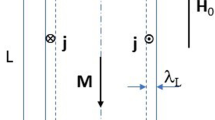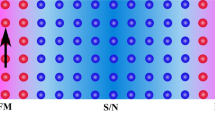Abstract
The features of the Meissner effect in superconductors with a finite pairing momentum are analyzed. Response to a weak magnetic field is calculated for various cases covering a pair momentum range from q ≪ Δ/v 0 to q ∼ p 0, including q = Δ0/v 0 (v 0 is the velocity on the Fermi surface and Δ0 is the order parameter at zero temperature; the system of units where ħ = 1 is used). The response of a superconductor carrying the transport current at a temperature close to the critical temperature T c is determined. It is shown that, at a certain critical momentum (current), the response parallel to the momentum vanishes and the London length is infinite. The response perpendicular to the momentum remains unchanged. The response of the superconductor in the current state at zero temperature is calculated. A new contribution to the paramagnetic current is found, and its mechanism is determined. This contribution can be large for high momenta q ∼ p 0. The Meissner effect is analyzed in detail for the state proposed by Larkin and Ovchinnikov, Zh. Éksp. Teor. Fiz. 47, 1136 (1964) [Sov. Phys. JETP 20, 762 (1964)], as well as by Fulde and Ferrel, Phys. Rev. A 135, 550 (1964). It is shown that the response parallel to the vector q is nonzero and diamagnetic. On the contrary, the response perpendicular to the momentum vanishes at the optimal momentum q 0. The sensitivity of the Meissner effect to the fine features of the superconducting state such as the quasiparticle spectrum, coherent factors, etc. is demonstrated.
Similar content being viewed by others
References
C. N. Yang, Phys. Rev. Lett. 63, 2144 (1989).
V. I. Belyavskiĭ, V. V. Kapaev, and Yu. V. Kopaev, Zh. Éksp. Teor. Fiz. 118, 941 (2000) [JETP 91, 817 (2000)].
A. I. Larkin and Yu. N. Ovchinnikov, Zh. Éksp. Teor. Fiz. 47, 1136 (1964) [Sov. Phys. JETP 20, 762 (1964)].
P. Fulde and R. A. Ferrel, Phys. Rev. A 135, 550 (1964).
A. A. Abrikosov, L. P. Gor’kov, and I. E. Dzyaloshinskiĭ, Methods of Quantum Field Theory in Statistical Physics (Fizmatgiz, Moscow, 1962; Prentice Hall, Englewood Cliffs, N.J., 1963).
P. G. de Gennes, Superconductivity of Metals and Alloys (Benjamin, New York, 1966; Mir, Moscow, 1968).
V. F. Elesin and Yu. V. Kopaev, Usp. Fiz. Nauk 133, 259 (1981) [Sov. Phys. Usp. 24, 116 (1981)].
A. V. Svidzinskiĭ, Spatially-Inhomogeneous Problems of the Theory of Superconductivity (Nauka, Moscow, 1982) [in Russian].
J. Bardeen, L. Cooper, and J. Schrieffer, Phys. Rev. 108, 1175 (1957).
Author information
Authors and Affiliations
Additional information
Original Russian Text © V.F. Elesin, 2007, published in Zhurnal Éksperimental’noĭ i Teoreticheskoĭ Fiziki, 2007, Vol. 131, No. 5, pp. 938–948.




